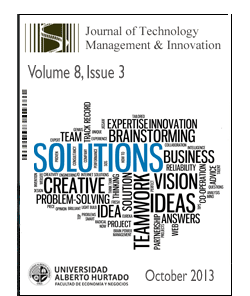Measuring Innovative Capacities of the Georgia Regions
DOI:
https://doi.org/10.4067/S0718-27242013000400011Keywords:
regional innovation systems, composite indicator, factor analysis, clusters, developing countries, countries in transitionAbstract
European Union (EU) experience reveal that the composite indicators are probably the most useful instruments for measuring the innovative capacities at the regional (sub-national) level. However, some gap exists in the current literature with respect to the elaboration of composite indicators for regional innovation systems (RISs) of developing countries. This article introduces the composite indicators GRIS and GCLS for measuring the regional innovative capacities (for GNUTS1 and GNUTS2 territorial classification levels, respectively). Georgia is a useful case-subject because its smallscale developing economy presents special challenges for elaborating the composite indicators for RISs. This article also includes a brief analysis using these composite indicators and indicates the significant heterogeneity among the innovative capacities of the Georgian regions.Downloads
References
Ajmone Marsan, G., Maguire, K. (2011). Categorisation of OECD Regions Using Innovation-Related Variables. OECD Regional Development Working Papers, 2011/03.
Archibugi, D., Coco, A. (2004). "New Indicator of Technological Capabilities for Developed and Developing Countries (ArCo)." World Development 32(4): 629-654.
Asheim, B., Smith, H., Oughton, C. (2011). Regional Innovation Systems: Theory, Empirics and Policy. Regional Studies, 45:7, pp. 875-891.
Bhutto, A., Rashdi, P.L., Abro, Q.M. (2012). "Indicators for Science and Technology Policy in Pakistan: Entering the Science, Technology and Innovation Paradigm." Science and Public Policy 39: 1-12.
Castellacci, F., Natera, J. (2011). A new panel dataset for cross-country analyses of national systems, growth and development (CANA). Norwegian Institute of International Affairs.
Chen, D. H. C., Dahlman, C. J. (2005). The Knowledge Economy, the KAM Methodology and World Bank Operations. Washington, D.C.: The World Bank.
Cooke, P., Uranga M. J., Etxebarria, G. (1997). "Regional Innovation Systems: Institutional and Organizational Dimensions." Research Policy 26: 475-491.
Doloreux, D., Parto, S. (2004). "Regional Innovation Systems: A Critical Synthesis." Institute for New Technologies, United Nations University.
Ejermo, O. (2009). "Regional Innovation Measured by Patent Data—Does Quality Matter?", Industry & Innovation, Taylor and Francis Journals, vol. 16(2), pp. 141-165,
EUROPEAN COMMISSION (2007). “Innovation Clusters in Europe: A statistical analysis and overview of current policy support”, DG ENTERPRISE AND INDUSTRY REPORT, Europe Innova / PRO INNO Europe paper n° 5
EUROSTAT (2008). “NACE Rev.2 Statistical classification of economic activities in the European Community”, EUROSTAT
Paas, T., Vahi, T. (2012). "Regional Disparities And Innovations In Europe”, European Regional Science Association, ERSA conference papers, ERSA 12, p80.
Gregersen, B., Johnson, B. (1997) "Learning Economies, Innovation Systems and European Integration." Regional Studies 31(5): 479-490.
Hollanders, H. (2007). 2006 European Regional Innovation Scoreboard (2006RIS). Maastricht: MERIT.
Klenow, P., Rodriguez-Clare, A. (1997). The Neoclassical Revival in Growth Economics: Has It Gone Too Far? , NBER Macroeconomics Annual 1997, 12, 73-103.
Moreno, R., Miguelez, E. (2011). "A relational approach to the geography of innovation: a typology of regions", IREA Working Papers 201121, University of Barcelona.
Nicoletti, G., Scarpetta, S., Boylaud, O. (2000). "Summary Indicators of Product Market Regulation with an Extension to Employment Protection Legislation". Economics department working papers 226, ECO/WKP (99)18, OECD.
OECD (2001). “Innovative Clusters. Drivers of National Innovative Systems”. OECD
OECD/EUROSTAT (2005). “The Measurement of Scientific and Technological Activities. Oslo Manual (3rd edition)” , OECD.
Padilla, R., Vang, J., Chaminade, C. (2008). RIS and Developing Countries: Linking firm technological capabilities to regional systems of innovation. WP 2008/13, CIRCLE, Lund University.
Porter, M.E. (1998). “Clusters and the new economics of competition,” Harvard Business Review. Nov/Dec 1998, Vol. 76, Iss. 6.
Saisana, M. (2008). 2007 Composite Learning Index: Robustness Issues and Critical Assessment. European Commission Joint Research Centre.
Tijssen R., and Hollanders H. (2006). Using science and technology indicators to support knowledge based economies. United Nations University.
UNU-MERIT (2010). European Innovation Scoreboard (EIS) 2009:Comparativ analysis of innovation performance . European Union.
Downloads
Published
How to Cite
Issue
Section
License
Copyright (c) 2013 Journal of Technology Management & Innovation

This work is licensed under a Creative Commons Attribution-ShareAlike 4.0 International License.












